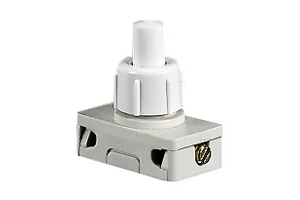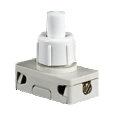Foot Switches - How They Work

Figure 1: A Legrand foot switch
A foot switch is a type of switch that is operated by foot pressure, allowing the user to control a device or machine without using their hands. This hands-free operation is particularly beneficial in applications where freeing up the hands for other tasks is advantageous or necessary. This article uses the Legrand mini foot switch as an example to provide an overview of foot switches in general.
Table of contents
- How a foot switch works
- Operating principle
- How to wire a foot switch
- Applications
- Foot switch symbol
- FAQs
How a foot switch works
The Legrand foot switch operates by toggling between ON and OFF states, allowing the user to activate or deactivate connected devices without using their hands. The switch features a locking mechanism, which means it can maintain its state (either ON or OFF) until it is intentionally changed by the user.
Latching vs momentary foot switches
Foot switches are essential components in various applications, from industrial machinery to musical instruments, and they come in two primary types based on their operation: latching and momentary.
Latching foot switches
Latching foot switches are designed to maintain their state after being activated. When you press down on the activation mechanism (such as a button or lever) of a latching foot switch, it changes state and stays in that position even after you remove your foot. To revert to the original state, you need to press the switch again. This type of switch is particularly useful in situations where you need a sustained action without continuous pressure. For example:
- Industrial equipment: In machinery, latching foot switches can be used to start or stop a machine, ensuring it remains in the desired state until manually changed.
- Lighting systems: Latching switches can control lights, keeping them on or off until the switch is pressed again.
- Musical instruments: Guitarists often use latching foot switches to toggle effects pedals on and off, allowing them to focus on playing without having to keep their foot on the switch.
Momentary foot switches
Momentary foot switches, on the other hand, are designed to return to their default state once the pressure is removed. When you press down on the activation mechanism, the switch changes state, but it reverts as soon as you lift your foot. This type of switch is ideal for applications requiring temporary activation. For example:
- Medical equipment: In medical devices, momentary foot switches can be used for actions like activating a surgical tool, ensuring the tool only operates while the switch is engaged.
- Industrial controls: Momentary switches are often used in machinery for tasks like operating a press or a cutter, where the action should only occur while the switch is actively pressed.
- Musical instruments: Keyboard players might use momentary foot switches as sustain pedals, where the sustain effect is only active while the pedal is pressed.
Operating principle
The Legrand foot switch's operating principle follows the steps below, which are specific for a foot switch with a latching mechanism.
- Foot activation: The switch is designed to be operated by foot pressure. When the user steps on the switch, it changes its state from OFF to ON or vice versa.
- Locking function: The locking switch function ensures that the switch remains in its current state until the user applies pressure again. This is useful for applications where a constant state is required without continuous pressure.
- Ingress protection: With an IP20 rating, the switch is protected against solid objects larger than 12.5 mm but is not protected against water. This makes it suitable for indoor environments where it is unlikely to encounter moisture.
- Contact configuration: The switch includes two normally open (NO) and two normally closed (NC) contacts. This allows for versatile wiring configurations depending on the requirements of the connected devices.
How to wire a foot switch
Like any switch, a foot switch is a break in a circuit that can be open or closed to control electricity flow through the circuit. A normally open (NO) foot switch blocks flow through the circuit when in the OFF state and allows flow when in the ON state. A normally closed (NC) foot switch operates oppositely. Some foot switches, like the Legrand mini foot switch, have terminals for normally open and normally closed, meaning they can be wired to operate as either type.
Wiring steps
The following steps are an example of how a basic foot switch may be wired. Refer to a foot switch wiring diagram before attempting to wire.
- Identify contacts: Locate the NO and NC contacts on the switch. These are usually marked on the switch housing or in the product documentation.
- Prepare wires: Cut and strip the insulation from the ends of the wires that will be connected to the switch.
-
Connect NO contacts:
- Connect one wire from the power source to one of the NO terminals.
- Connect another wire from the other NO terminal to the load (device you want to control).
-
Connect NC Contacts (if needed):
- Connect one wire from the power source to one of the NC terminals.
- Connect another wire from the other NC terminal to the load.
- Insulate connections: Ensure all connections are properly insulated to prevent short circuits or accidental contact.
- Test the switch: Once wired, test the switch by applying foot pressure to ensure it toggles the connected device(s) correctly.
View our online selection of wire stripping tools!
Applications
- Medical equipment: Foot pedal switches are often used in medical devices to allow hands-free operation, ensuring sterility and convenience.
- Industrial machinery: Foot switches are used to control machinery, enabling operators to keep their hands free for other tasks (Figure 2).
- Musical instruments: Foot switch pedals are commonly used with electric guitars and other musical instruments to control effects and settings.
- Sewing machines: Foot pedal switches are essential for controlling the speed and operation of sewing machines.
- Office equipment: Foot switches can be used to operate dictation machines and other office equipment, allowing for hands-free control.
- Lamps and lighting: A foot switch for lamps provides a convenient way to turn lights on and off without using hands.
- Power tools: Foot pedal switches are used to control power tools, enhancing safety and efficiency.
- Computers and gaming: Foot switches can be used to control computer functions or gaming actions, providing an ergonomic alternative to hand controls.
NC vs NO foot switches
Because foot switches can be NC or NO, it's useful to understand some applications where each type is more suitable than the other.
-
Normally closed foot switches
- Emergency stop controls: In machinery and equipment, NC foot switches can act as emergency stop controls. When the switch is pressed, the circuit opens, immediately stopping the operation.
- Continuous operation control: For processes that need to run continuously unless interrupted, NC foot switches are ideal. The machine operates as long as the switch is not pressed.
- Security systems: NC foot switches can be used in security systems where breaking the circuit (by pressing the switch) triggers an alarm or other security response.
-
Normally opened foot switches
- Momentary activation: NO foot switches are suitable for applications requiring momentary activation, such as activating a tool or machine only while the switch is pressed.
- Start/Stop controls: In scenarios where an operator needs to start or stop a machine with a foot switch, NO switches are used. Pressing the switch closes the circuit and starts the machine.
- Signal sending: NO foot switches can be used to send signals, such as in musical instruments (e.g., sustain pedals for keyboards) or communication devices.

Figure 2: A pedal foot switch used to operate a machine.
Foot switch symbol
As seen in Figure 3, there are P&ID symbols for normally closed and normally open foot switches.

Figure 3: A normally closed foot switch symbol (left) and normally open foot switch symbol (right).
FAQs
What is a foot switch?
A foot switch is a device operated by foot pressure to control electrical circuits, often used for hands-free operation in various applications.
How does a foot switch work?
A foot switch works by closing or opening an electrical circuit when pressed, allowing or interrupting the flow of electricity to connected devices.
What are the types of foot switches?
Types of foot switches include momentary, maintained, and multi-function switches, each serving different operational needs.
How do you wire a foot switch?
To wire a foot switch, connect the switch terminals to the device and power source according to the wiring diagram, ensuring proper insulation and secure connections.





